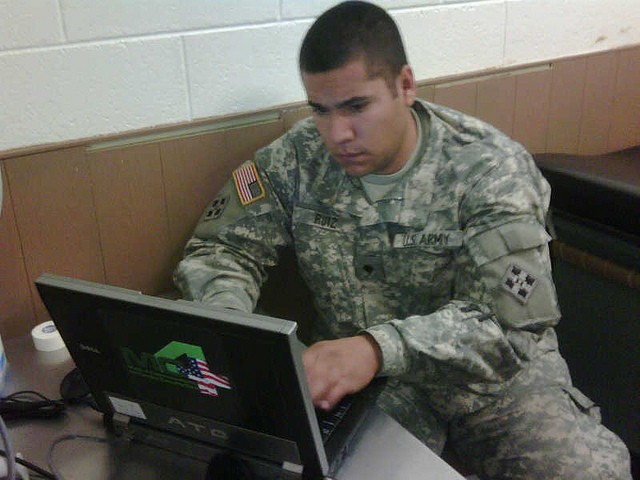Fifty-seven battalion aid stations in garrison now use Medical Communications for Combat Casualty Care (MC4) systems to digitally chart patient care. The 2nd Brigade Combat Team (BCT), 4th Infantry Division (ID) at Fort Carson, Colo., and the 159th Combat Aviation Brigade (CAB), 101st Airborne Division at Fort Campbell, Ky., are the latest to join the growing list of units using MC4 outside of Southwest Asia.
From 2008 to 2009, 37 battalion aid stations in garrison transitioned from paper records to MC4, once a battlefield-only system. The <a href="http://www.army.mil/-news/2009/01/30/16288-stateside-clinic-begins-using-battlefield-mc4-system/">82nd Airborne Division</a> at Fort Bragg, N.C., <a href="http://www.army.mil/-news/2009/04/30/20427-stateside-clinics-switch-to-battlefield-medical-recording-system/">3rd ID</a> at Fort Stewart, Ga., <a href="http://www.army.mil/-news/2009/09/02/26872-providers-in-south-korea-see-both-sides-of-the-electronic-medical-record/">2nd ID</a> in South Korea and 7th Army in Europe installed MC4 to fill a need for electronic medical recording (EMR). The system also supports their adoption of the Army's "train as you fight" model. To date, garrison aid stations have captured 53,000 patient encounters and transmitted countless medical supply orders electronically.
Preparing for Southwest Asia, Maj. Theodore Stefani, 2nd BCT, 4th ID brigade surgeon, initiated the use of MC4 systems for outpatient care (AHLTA-T) in the brigade's six battalion aid stations. The unit uses MC4 hardware to connect to Evans Army Community Hospital at Fort Carson via Enterprise Remote Access (ERA), a virtual private network connection. The tool allows them to order X-rays and lab tests, as well as view inpatient care notes.
"The combination of MC4 and ERA allows us to move away from paper records and prepare for theater requirements," Stefani said. "My medics tested the network and charted 10 encounters the first day the systems were in place."
"Now, we electronically capture 25 patient notes daily," Stefani continued. "We offer a seamless transition of medical documentation for Soldier care, helping them when they move to new duty stations and eventually leave the military."
Garrison use of MC4 not only fills a need for digital medical recording, vice paper records, but readies Soldiers for downrange use and support. Maj. Roby Randall, Fort Carson Medical Department Activity chief information officer, previously deployed to Iraq as the health information systems officer with the 10th Combat Support Hospital (CSH). He understands the benefits the technical staff will reap by supporting MC4 at Fort Carson.
"Before the 10th CSH deployed in 2009, my team was not familiar with MC4 systems," Randall said. "In the beginning, we didn't understand all of the support requirements and we experienced a steep learning curve. Supporting the systems on a daily basis will help the unit level administrators to avoid those same struggles."
To build on the use of MC4 in garrison, Stefani will include the systems in field exercises. He plans to test his technical support team's readiness and practice using MC4's command and control capabilities.
"The technical team gets the opportunity to practice setting up the systems in case the unit arrives in theater and does not fall in on an established network," Stefani said. "I'll also have the opportunity to review patient data for medical surveillance requirements."
While MAJ Stefani's unit prepares for MC4 use in theater, Sgt. 1st Class Shayne Henricksen, medical platoon sergeant and noncommissioned officer in charge of the 563rd Aviation Support Battalion, 159th CAB, 101st Airborne Division, readies his unit for MC4 in the states.
"Instead of the equipment being locked away in a CONEX until the next mission, we're using the MC4 systems like we did in Afghanistan," Henricksen said. "Daily use of the same system can only help the user."
In May, the 159th CAB installed 17 MC4 systems in their 12 battalion aid stations and the brigade medical supply office at Fort Campbell. In one month, the unit digitally documented 400 patient encounters and ordered approximately 20 items of medical supplies each week via MC4.
Henricksen believes his staff will be better prepared to build on lessons learned with MC4 in garrison.
"If we had used the system in the aid stations before we deployed, we would have had a much easier time at the start of our deployment," Henricksen said. "For our next mission, we'll have a database of our Soldiers on our computers. We'll spend less time entering demographic data and be ready to use the systems as soon as we hit the ground. We're able to build upon our experiences and provide a complete medical picture."
Related Links:
Army.mil: Science and Technology News
STAND-TO!: Release of Protected Health Information to Commanders


Social Sharing